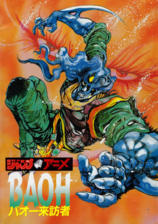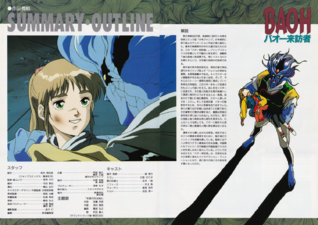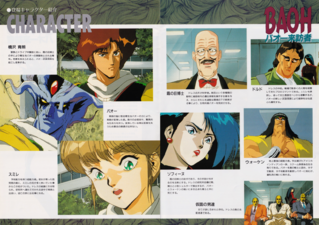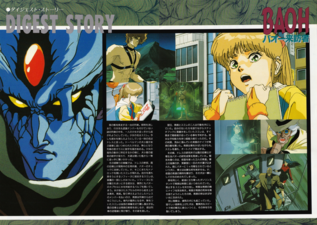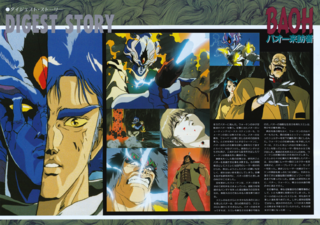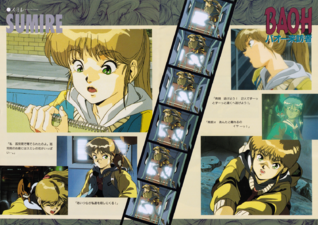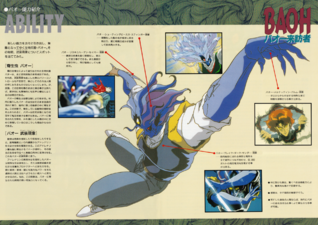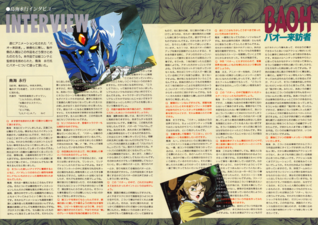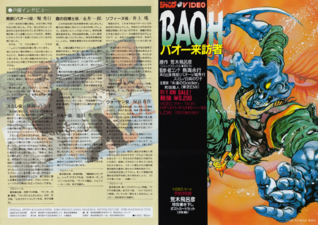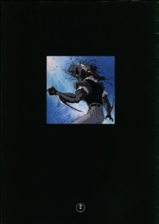Baoh OVA Pamphlet (September 1989)
Pafu (April 1989)
Interview Archive
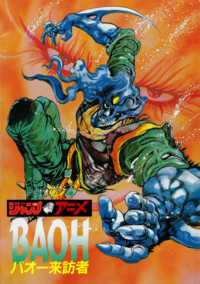
Interviews and commentary from the cast and crew of the Baoh the Visitor OVA included in the OVA's theatrical pamphlet. These include an interview with chief supervisor and storyboard artist Hisayuki Toriumi, as well as comments from the following voice actors: Hideyuki Hori (Ikuro Hashizawa), Ichiro Nagai (Dr. Kasuminome), Yo Inoue (Sophine), Noriko Hidaka (Sumire), Shuichi Ikeda (Dordo), and Yusaku Yara (Walken).
Interview
Hisayuki Toriumi
Born in Yokohama in 1941. Graduated from Chuo University. After working at Tatsunoko Production, he joined Studio Pierrot. Notable works of his include Science Ninja Team Gatchaman, The Wonderful Adventures of Nils, The Mysterious Cities of Gold, Dallos, Area 88, and Lily C.A.T., among others.
Q: First of all, can you tell us about your first impression of the original work?
Toriumi: I was shocked. To be honest, it was quite a surprise. I don't usually read violent comics regardless, but I was still surprised to see how far comics have come nowadays. I was also impressed by the outrageous things young people think up nowadays. They really have flipped common sense on its head. For example, the scythe coming out of Baoh's arm was something we used to have to do with props in the past. He fights by transforming his body itself into that kind of weapon. That was wild to me.
Q: As you marveled at those new ideas, was there any doubt in your mind as to whether you could get away with visualizing those extreme depictions of violence in the film?
Toriumi: That's my biggest concern. There was a lot of discussion around the topic at first, but we couldn't come up with a clear answer, and in the end we decided to go with whatever was within the scope of the original work. Even then, when you watch the animation on the screen, it somehow lacks that sense of unpleasantness we aimed to recreate. It's simply impossible to recreate the texture of it. However grotesque you draw them, the images look beautiful once cel-shaded. So no matter how much blood is splattered, I don't feel the slightest bit uncomfortable watching it. The mutilation scenes are disgusting, but it doesn't carry the same shock value as, say, The Fly. On the contrary, I thought that if those kinds of scenes accumulated and were made more dynamic than unpleasant, the sadness of the protagonist, who has been altered without his permission and is no longer a regular human being, would rise to the surface. He loses his speech when he transforms into Baoh, so it was necessary to have him express it with his entire body. The other characters in this film really don't have many lines either, though.
Q: It's not just the dialogue; the cast of characters is also rather sparse.
Toriumi: Normally, the story is told through dialogue, but in Baoh the story is told through movement. Ultimately, it attempts to express the contrast between the intensity, the subtlety, and the loneliness of the action through both stillness and movement.
Q: What were you particularly attentive toward when supervising the film?
Toriumi: When I storyboarded the film, though it was very difficult, I made sure to only include one action per cut. Previously, there were cases where we would put 10 to 20 movements in a single cut, and sometimes they could take up a long stretch of time. Naturally, the cuts are shorter, but it's still a lot of work overall. Faces are melted, arms are cut off, et cetera, but it doesn't really matter how shocking they are in the drawing stages, so I left it up to the director. I wonder how difficult it'd be to keep doing things that way again and again.
Q: I was shown the storyboards earlier, and you gave very detailed instructions as to how to handle firearms and depict cartridges popping out, and so on; for example, "don't use repeats for this shot," and so on. Is that because you wanted to maximize the grade of each movement?
Toriumi: It's difficult to accurately convey my intentions to others. The parts I want to be done in one way are ignored, and the parts I don't want to be done in another way are persistently done that way. So I just gave them instructions on what I wanted them to do. Realism is expressed in the subtlest of ways. Just the characters being realistic doesn't make the whole thing realistic, right? Realism is felt through the smallest details of the work.
Q: Were there any particular aspects of the work itself, like the drawing or recording, that you paid particular attention to this time around?
Toriumi: Regarding filming techniques, each studio has their own restrictions, so we can't give too many unreasonable orders. As for the audio, we had a meeting the other day about Baoh's "barubaru" cry. That howl is a sound that can be transmitted through either the vocal cords of an animal or a human being, so we decided to make the most of it. It is the bark of a monster, but unlike the howl of a dog, which sounds like "wooooooo," it has to be a "barubarubaru." It's rather like the sound of a motorcycle's exhaust pipe. I don't want it to be a mechanical sound, but rather a voice coming from a human throat. I want the bark to express emotion. It has to vary based on that, whether Baoh is grieving, furious, or defensive. I believe that Baoh's howl will make or break this work.
Q: What is the one thing you wanted kept in mind above all else in Baoh?
Toriumi: It's just a matter of screen composition, but I asked them not to use the common practice of dividing the screen into three or four screens via masking. If you were to ask me why, I would say that there's just no need to go to the trouble of dividing the screen into smaller pieces. A movie's coherence comes from following the images within a frame, and dividing a picture into two parts, one on the right and the other on the left, should only be used when it is found to be the most effective. It's not something you can do just for fun. So I want it to be realistic and vivid. The other thing is that, if I have captured a close-up of Baoh's face from a frontal view, I don't want it to be changed without my permission just because it would look cooler as a low-angle shot. Of course, if it were a single picture, it would be cooler to draw the face from below rather than from the front. But that would ruin the interactions between each cut. For example, when two people are talking together, like we're doing now, there's no need to use low-angle shots at all. And that's what I'm concerned about. Since Baoh is an action movie, it's tempting to try and make every picture as cool as possible while ignoring the flow of the story. I tried to keep that in check as much as possible to create an atmosphere that emerges from the screen.
Q: In the opening scene, the way Sumire escaping her room and Sophine chasing her is depicted gives off the impression of a suspense film from the 1960s.
Toriumi: Yes, that's right. Since Baoh is a bloody world, I felt that I could bring out a bit of romanticism in the way the suspense builds there.
Q: I'd like to ask what your favorite scene in the entire film is.
Toriumi: Hmm. Well, I like to build up suspense with a quiet mood. The scene that I was most careful about in the storyboarding stage was the one where Sumire and Ikuro are attacked in an abandoned building. Ikuro doesn't even know what he looks like as he fights there. The part I'd like to see handled with the most care is the part where he sees his reflection in the mirror.
Q: Conversely, is there anything you think should have been handled a little better?
Toriumi: I was most concerned about Nozzo. I think Mr. Hirohiko Araki, the author of the original story, was planning to use her for something, but in the end he simply couldn't use her effectively enough. She's a fictional animal, so to have her appear means he must've been planning to use her to progress the story somehow. It really is a shame.
Q: Did you gain anything new from working on Baoh?
Toriumi: Yes. I enjoyed getting to know the animators and other new members that I had never met before. When I saw the finished film, I discovered new things about it that I didn't even know were possible.
Q: What theme did you want to convey in Baoh?
Toriumi: It's not a particularly grandiose theme, but there are times when people cannot convey their true intent to others. Even if there's no malicious intent involved, our inability to convey our intentions causes us to be misunderstood and judged as such. When Ikuro transforms into Baoh, he is unable to communicate with others, and no one understands that he is still Ikuro. The question is why Baoh still fights for others, lonely as he is. I think it's interesting that he isn't simply heroic with a sense of justice.
Q: Is there any policy that you keep in mind when creating your films?
Toriumi: It's a simple one. I try to convey to the viewer the entire world that I bring forth. The most important thing is to not make any typos. There are people who say that if you try to make your films too easy to understand, they become boring. But I think it's important not to just tell a story where people will think, "Ah, so that's the message of their filmography." In order to convey the message of the work via the story, I must emphasize the importance of grammar. We use Japanese grammar to enhance the Japanese language, and the same can be said of film.
Q: Do you hope to continue making films like this in the future?
Toriumi: Well, I still haven't decided what kind of film I'm best suited for. It just so happens that I started out in the action genre, and since I do those so well, people tend to assume they're my specialty. I wanted to do something fairy tale-like, but the opportunity never presented itself. Things had been that way for over a decade, so it was fun when I started working at Pierrot. I thought it would be fun to look at things through the eyes of a child. In the end, both action and fairy tale works are enjoyable in their own way, but I don't think animation is limited to simply the realm of entertainment. When I watch When the Wind Blows, for example, I think to myself that this is the kind of work we really need to be creating. That's something our generation is a bit particular about, so in a sense, it's a very Japanese reflection to make. When the Wind Blows was an exception, but when we first entered the world of animation, we were ridiculed for it, since animation was just something for children to watch. But if children are watching it, their parents must be watching it, too, so we came together as an organization to create works that the parents wouldn't scoff at. We wanted to create films that could be watched by both children and adults. It's a bit extravagant, saying it out loud, but that's the kind of film I'd like to make.
Q: Finally, do you have a message for the fans out there?
Toriumi: Considering the current social climate, a work like this has phenomenally bad timing (laughs). So I want the audience to grasp not just the superficial action, but also the heart of Ikuro deeper within. The action is just decoration, so can you try and look at the core of it? We are creating this work here around being able to understand that. I don't know if we're living through a yōkai boom or not, but I would like the meaning behind the existence of yōkai to become more apparent. If it properly depicts a sense of human psychology and the value of existence, the meaning behind these monsters and yōkai existing, appearing where they do, then I think Baoh will turn out just fine. It shouldn't be just about slaughter or shock value. I hope that the audience for this film won't be caught up in the violence on the surface, but will instead sense the message of the filmmakers beneath all the violence.
鳥海 永行
1941年、横浜生れ。 中央大学卒。
竜の子プロを経て、スタジオぴえろ設立に加わる。
代表作「科学忍者隊ガッチャマン」
「ニルズのふしぎな旅」
「太陽の子エステバン」
「ダロス」
「地域88」
「LILY-C.A.T」など
Q まず原作を読まれた第一印象から聞かせて頂けますか。
鳥海 本当にビックリしましたよ。正直これは驚きでしたね。僕はもともとバイオレンス系統のモノは読まないんですが、今のコミックはここまでやっているのかっていう感じでしたね。それから今の若い人はホントとんでもない事考えるんだなって感心しました。常識をひっくりかえしてしまっているんですよ。例えばバオーの腕から鎌が出てくるっていうのは、僕等は昔、小道具を持たせてやっていた訳ですね。自分の体をそういった武器に変化させて戦ってゆく。これはとんでもない事考えるんだなと思いました。
Q そういった新しいアイデアに驚嘆するとともに、バイオレンスのきわどい描写を映像化してもいいものかといった疑問を持たれませんでしたか。
鳥海 それは一番気になるところなんですけどね。それについては最初色々ディスカッションしたんだけど明解な答えが得られなくて、結局、原作の中でやっている範囲内の事ならともかくやってみようという事になったんです。それからアニメーションも画面を観て頂くと案外狙った気持悪さは出ないんですよ。質感の表現にどうしても無理があるんですね。グロテスクに描いても、セル画になったものはキレイに見えてしまうんです。だからどんなに血しぶぎ出したってそんなに観てて気持悪くはならない。切るという行為は抵抗感じますけど、例えば「ザ・フライ」を観たような、ああいうショックはおきないんだと。逆にそういうシーンを積み重ねて気持悪さよりもダイナミックさが出れば、勝手に改造されて普通の人間ではなくなってしまった主人公の悲しみが出てくるのではないかと思ったんです。彼はバオーになると言葉を失うわけですから、それを体全体で表現させる必要があるわけです。主人公に限らず、この作品は本当にセリフが少ないんですよ。
Q セリフのみならず、登場キャラクターも比較的少なめですね。
鳥海 普通はセリフでドンドンドンドン積み重ねていくのに対して、「バオー」は動きの積み重ねにより物語を語らせているんです。結局それはアクションのすさまじさと孤独さの部分の対比を「静」と「動」でもって表現しようとしているものなんですね。
Q 今回演出をされる上で、特に意識した事というのはあるのでしょうか。
鳥海 僕の方は絵コンテを切るときに、大変だとは思いますけども、ワンカット、ワンアクションしか入れてないんですよね。今までですとワンカットの中に芝居を10も20も突っ込む場合もあるし秒数を長くとったりする事もあるんですけど。当然カットは短くなりましたが、それでも全体的に大変でしょうね。顔が溶けたり腕を切ったり、それを絵の段階ではどんなにショックでもかまわないって事で、演出家さんにふりましたから。そういった事を重ねていくのは難しいんじゃないのかなって気もしますけどねェ。
Q 絵コンテを見せてもらったんですが、銃器の扱いに関してや
鳥海 自分の意向を正確に相手に伝えるのは難しいんですよね。こちらが「こうやって欲しいのに」っていうとこは案外サラッと無視されちゃって、「ここはどうだっていいのに」というところをしつこくやるというのがありますから。だから気になる所だけは、「こうして下さい」って指示をさせてもらいました。リアルさというものはなにげない所ででてくるんですよね。キャラクターがリアルだからリアルってわけではないんじゃないですか?芝居のちょっとした所にリアルさを感じるっていう事あるでしょ。
Q 作画や録音等の実作業の点で、今回特にこだわった点というのはあるでしょうか。
鳥海 撮影技術に関しては、各スタジオごとに制約がありますから、あまりムチャな注文は出せないんです。音響では、この前も打合せをしたんですが、バオーの「バルバル。」ですね。あの吠え声、あれがあくまで動物の、人間の声帯を伝わってくるものであるから、これはとにかく大事に作っていこうと。怪獣の吠え声には違いないんだけれども「ウォー」っていう犬の遠吠えとは違って「バルバルバル。」っていう「ル」音が入りますからね。オートバイの排気音に近くなるんでしょうか。これは機械音ではなく、あくまで、人間のノドから流れてくる声にしてもらいたいんです。その吠え声だけでもって感情表現してもらいたいと。悲しい時のバオーとか、怒りのバオーとか、怒りを耐えてる場合のバオーとか、色々ある訳ですから。この作品を良くするか悪くするかがこのバオーの吠え声で決まってしまうと思いますね。
Q この「バオー」の中で、これだけは押さえておきたかったポイントというのは何でしょう。
鳥海 画面の構成上の問題なんですけども、よくやるマスクに分けて画面を3つ4つに分けるやり方、こういう事はやめてくれとお願いしました。それは、なぜと聞かれれば、せっかくの画面をわざわざ細かく分ける必要は無いんだと。映画というのはあくまでフレームの中でもって画像を追っていって説明するもので、右に誰かの絵、左に誰かの絵って分けてしまうのは、それが一番効果的だと判断した時に使うべきなんです。遊びでやるってものではないんですよ。だからあくまでリアルに、生々とした感じでやって欲しいと思っています。もう1つは、例えばバオーの顔のアップを僕が正面顔でとらえたとすると、それを作画する時に、アオリの方がかっこいいからといって勝手に変えられては困るという事です。そりゃあ、1枚の絵だったら正面の顔描くよりも、アオった方がかっこいいですよね。でもそれではカットがつながっていかなくなる。例えばこうやって2人で一緒に話している時にアオリを使う必要は、全くないですよね。僕が気になるのはそういうところなんですよ。前後の流れというものを無視されて1枚の絵のかっこよさを追究されちゃうと、ついバオーっていうのはアクション物ですからそっちの方に流れやすいんですね。なるべくそれを抑えて画面から醸し出される雰囲気作りに専念しました。
Q 冒頭のシーンなんですけども、部屋を脱出したスミレとそれを追うソフィーヌの描写が60年代のサスペンスタッチな映画という印象を受けたんですが、それは意識されての事ですか。
鳥海 そうですね。「バオー」は血みどろの世界ですから、ちょっとロマンティックな香りみたいなものがサスペンスの盛上げ方とかで出せればな、という気がしたんです。
Q 全編を通して監督の「ここはっ」というお薦めシーンをお聞きしたいのですが。
鳥海 んー。どちらかというと僕は静かなムードでサスペンスを盛上げるのが好きでしてね。一番、絵コンテの段階で気をつかっているのは、スミレと育朗が廃墟のビルに居てそこを襲われるという、あのへんのくだりなんです。あの中で戦っている育朗が自分がどういう姿をしているかわからない。それが鏡に映しだされる事によりわかってくるあたりを一番丁寧にやってもらいたいんですが。
Q 逆にここはもう少しこうすべきであったという所はありますか。
鳥海 一番気になってたのはノッツォなんですね。あれは原作の荒木(飛呂彦)さんも何かに使おうと思ってらしたと思うんですよ。それが十分有効に活されていない。あれは架空の動物ですから、そういうものを登場させたのならストーリーを展開していく上で何かにからませたかった。それが残念です。
Q 今回「バオー」にたずさわられて、監督自身何か新しいものを得られたという事はあるでしょうか。
鳥海 ええ、アニメーターを始め、これまでおつきあいの無かった新しいメンバーと知り合いになれたのが楽しかったです。あがってきたフィルムを観せてもらって、「こういう事ができるのか。」っていう新しい発見もありました。
Q この「バオー」の中で監督がいいたかったテーマといったものは何でしょう。
鳥海 テーマという程大げさなものでもないですが、人間誰にも自分の本意が相手に伝わらないって事ありますよね。悪意がなくても本音を伝えられない事で誤解されて、あいつはこういう人間だって決め付けられてしまうっていう事が。育朗っていうのはバオーに変身してしまうと意志の疎通も出来ないし自分を育朗だと分かってくれる人もいない訳ですね。そういう孤独なバオーが人の為に戦うのはなぜなのかといったところなんです。単なる正義感のヒロイズムじゃないところが面白いんでしょうね。
Q 監督自身がフィルム構成されていく中で、常に念頭に置かれているポリシーといったものはありますか。
鳥海 これはもう単純でしてね。観る人になるべく自分が訴える世界全部をわかるようにするって事ですね。文法を間違えちゃいけないって事を一番大事にしている訳です。わかりやすいように、わかりやすいようにってやるとかえってつまんないっていう人もいましたけどね。ああこの人は一作一作こういう事が言いたかったんだと、ただストーリーを教えるだけじゃいけないんですよね。ストーリーを通してこの作品はこういう事を訴えたいってものを出す為には、文法を大事にしていかなきゃいけない。僕等が日本語を喋るために日本語の文法を使っているのと同じように、映画にも同じ事が言えるんです。
Q 将来監督自身こういう作品を作ってみたいという希望はありますか。
鳥海 そうですね、自分にどういう作品があっているのか、まだ決めらんない部分があるんですよね。たまたま僕はアクションもので出てきたという事もあって、それなりの事ができちゃうとあいつはアクション物がいいだろうと勝手に決められてしまう部分があるんです。本当はメルヘンチックな物をやりたいと思ってもなかなかチャンスが巡って来ない。そういう経験が十何年と続いていましたから、ぴえろを作った時は楽しかったですよね。子供の目線と同じ高さで物を見ていく事は楽しい事だと。結局アクション物もメルヘン物も、やってみればそれなりの楽しさがあるんですが、アニメって、そういう娯楽作品しか作れないわけじゃないだろうと思うんです。例えば「風が吹く時」みたいに、ああいうの観てると本当にこういうのは我々が作んなきゃいけないんだと思いますね。ああいうものってのは僕等の世代ちょっとこだわりがあるから、ある意味では日本独特の反省になってしまう。そうじゃない感覚が「風が吹く時」だったんですけど、僕等がこういう世界に入った時アニメなんて子供が観るものだとバカにされた訳ですよね。ところが子供が観ていれば絶対親も観ている訳だからその親にどうのこうの言われない物をつくろうという組織でやってきたんです。子供から大人まで観られる作品。ていうのは贅沢な話ですが、いつか作ってみたいですよね。
鳥海 今、こういう社会事情ですからこういう作品は非常にタイミングがまずいんですよねぇ(笑)。だから僕は表面的なアクションだけでなく、あくまでも内側に流れている育朗の心をつかんで欲しいです。アクションはあくまでデコレーションで、その核をみてくれないでしょうか。それがわかるように現場では作っていますので。今、妖怪ブームみたいなものでそういうジャンルが受ける時代なのかもわからないけど、僕はその存在意味をもっと出してもらいたいと思っていますね。なぜこのバケモノや妖怪がいるのか、なぜでてくるのか、そこにもっと人間の心理をついているものとか、存在価値というものがちゃんと描かれていれば僕はこの「バオー」もいいと思うんですよね。それがただ殺される為に、ショックを与える為に、だけじゃいけないと思うんです。この作品では、表面のバイオレンスな部分だけに捕らわれず、その奥に込められた製作者側のメッセージを感じ取って頂きたいです。
Commentary
When I saw Baoh for the first time, I thought it was terrifying. However, Ikuro's character also conveyed the horror of having your own life altered by other people's hands, as well as the kindness that human beings possess. One of the lines that left a strong impression on me was, "I- Is this me? What is this...?" I think it showed Ikuro's emotional turmoil at the unbelievable reality before his eyes. If a sequel happens, I'd like to see him spend peaceful days of love with Sumire.
I always make sure to pay attention to the flow of the work and the character's personality, and I will continue to keep my heart beating and do my best in the future. In closing, I hope you all enjoy the video.
Profile
Hori was born in Tokyo and works for Aoni Productions. He has played the roles of Tatsuo Aku in Tiger Mask II, Warsman in Kinnikuman, and Ikki in Saint Seiya, among others.
バオーを初めて観た時は、かなり怖い作品だなと思いました。でも、他人の手によって自分の人生が左右されてしまう恐ろしさと人間が持っている優しさというものが、育朗というキャラクターを通じて伝わってくるのも感じました。
中でも、「こ これが俺か!? ……これが……。」という台詞は印象に残っています。信じられない事が現実として目の前に起こったという、育朗の心の動揺が良く現れていたと思います。もし仮に続編があるのなら、スミレちゃんとの愛と平和な日々を観てみたいですね。
いつも作品の流れとキャラクターの性格に気を付けているんですが、これからも常にハートを動かし続け、がんばって行きたいと思います。最後に、皆さんビデオ買ってね。
プロフィール
東京都出身、青二プロダクション所属。「タイガーマスクⅡ世」亜久 竜夫役、「キン肉マン」ウォーズマン役、「聖闘士星矢」一輝役、他で活躍中。
It's a bit unsettling that an insect can attach itself to someone's brain and transform them. But Ikuro is a very kind person, so I feel really safe somehow... My previous works have been rather heartwarming, so I was very excited to see a pattern of human faces melting and eyeballs popping out of people's heads.
As for the character of Sumire, I was really happy that she could meet Ikuro. I felt sorry for her because she was only nine years old, and she was almost taken advantage of by bad guys just because she was a psychic. I really am happy that she met Ikuro, who carried the same wound in his heart. "Ikuroooo! I don't want to be apart from youuuu!" I think that line conveys how painful it is to say goodbye to the first person you've been able to open your heart to (excluding Nozzo, who she grew up with in the orphanage). I simply had to picture the love story between the 17-year-old Sumire and the reawakened Ikuro!
In my voice acting work, I always try to act naturally. But someday, I'd like to perform in a musical.
Profile
Hidaka was born in Tokyo and works for KONO Productions. She has played the roles of Minami Asakura in Touch, Kanko Shirai in Tsuide ni Tonchinkan, and Satsuki in My Neighbor Totoro, among others.
虫が脳に寄生して、それによって変身するなんて、ちょっと気持ち悪いですね。ただ育朗がすごく優しい人なので、とっても救われてるな…と思いました。今まで私が出演した作品はどちらかというとほのぼのとしてて、人間の顔が溶けたり目玉が飛び出したりというこのパターンにはすごくドキドキしました。
スミレというキャラクターは、育朗という人に会えて本当に良かったと思います。超能力者という事だけで悪い人に利用されそうになったり、まだ9つの子なのに可哀相。そこで心に同じ傷を持つ育朗と会えた事は、本当に幸せだったと思いました。「育朗ォ、あんたと離れるの イヤーッ!。」という台詞からは、孤児院でいっしょに育ったノッツォ以外、初めて心を開いた人との別れの辛さが、ひしひしと伝わってくると思います。やっぱり17才になったスミレちゃんと見覚めた育朗との、ラブストーリーを作るっきゃないですね!
私は声の仕事をする上では、常に自然に演じる事を心がけています。でもいつかは、ミュージカルの舞台にも立ってみたいですね。
プロフィール
東京都出身、河野プロ所属。「タッチ」浅倉 南役、「ついでにとんちんかん」白井 甘子役、「となりのトトロ」サツキ役、他で活躍中。
This work reminded me of the Ishii Unit. It's a relief that Kasuminome dies at the end. You mustn't tamper with life. Science is the pursuit of truth, and that's natural. But philosophy hasn't caught up with science. Knowing about the nucleus is good, but the destitution of philosophy is what set off the atomic bomb. And now humans are messing with genes, while philosophy remains destitute. Something has to give. Kasuminome died without any philosophy, without enlightenment. Who will take up the task of creating honest philosophy? When will it happen? How long must we wait? I might have spoken a bit too seriously there, and I'm a bit embarrassed now.
I think Kasuminome's character is most evident in the line, "I pray for your safety." This man, who so callously disrespects human life, is willing to say so often, for the sake of his own greed, "I pray for your safety." I will continue to value reality and do my best to be both strong and durable.
Profile
Nagai was born in Osaka Prefecture and works for Aoni Productions. He has played the roles of Dyce in Future Boy Conan, Sakezo Sado in Space Battleship Yamato, and Cherry in Urusei Yatsura, among others.
この作品を見て石井部隊を思い出しました。霞の目が最後に死んでくれるのが救いでしょう。生命をいじくってはいけない。科学は真理を追求する。それは自然な事。しかし哲学が科学に追いついていない。核を知る事は良い。しかし、原爆を爆発させたのは哲学の貧困。
今、人間は遺伝子をいじくっている。哲学貧困のままに。何か起こるに違いない。霞の目は哲学を持たず、悟らないまま死んだ。一体、誰がまっとうな哲学を作ってくれるのか? いつになるのか? いつまで待つのか? 少々まじめに答えてしまって、照れております。
霞の目の性格が最も顕著に表れていたのは「無事を祈る。」でしょうね。これだけ人の命を軽んじる男が、自分の欲のためには「無事を祈る。」よく言うわと思いました。これからもリアリティを大切に、丈夫で長持ちを目標にがんばってゆきます。
プロフィール
大阪府出身、青二プロダクション所属。「未来少年コナン」ダイス役,「宇宙戦艦ヤマト」佐渡 酒造役、「うる星やつら」錯乱坊役、他で活躍中。
The character I played, Dordo, conveys a strikingly evil and maniacal image from the outside, but I believe that people are righteous no matter who they are. In voice acting work, you don't have the luxury of fussing over other people's lines, and the most you can do is play your role, or at least that's the conclusion I have come to.
I always believe that every day is a battle, and I want to come across as many good works as possible, so that feeling can grow even stronger. Because everyone involved worked hard on Baoh, I hope you too can savor that feeling to your heart's content.
Profile
Shuichi Ikeda was born in Tokyo and is a member of Haikyō. He has played the roles of Char Aznable in Mobile Suit Gundam, Rod Balboa in Giant Gorg, and Geoffrey Kurtz in Venus Wars, among others.
私がやったドルドという役は、上辺だけを見ると際立って狂悪なイメージを持つキャラクターなのですが、人はどんな者であれ正しい者だと思います。声の仕事というのは他の方の台詞を気にする余裕は無く、自分の役を演じきるのが精一杯なのですが、その中で感した結論がそれに当たるわけです。
私が常日頃から思っているのは「毎日が闘い」であるという事であり、それをより強く感じるためにも、一つでも多くの良い作品に出逢いたいと考えています。
この「バオー」という作品も、皆さん一所懸命やった作品ですので、心ゆくまでそれを感じて下さればと思います。
プロフィール
東京都出身、俳協所属。「機動戦士ガンダム」シャア・アズナブル役、「巨神ゴーグ」ロッド・バルボア役、「ヴイナス戦記」ジェフリー・カーツ役、他で活躍中。
I, unfortunately, had never heard of Baoh prior to now. Since the story is left incomplete, if there happens to be a sequel, will my Sophine come back to life? And, well, I'm saying this as a joke, but I hope there's not too much violence.
"Let's feel good about this." That's my credo. In other words, I want to perform in a way that satisfies myself. It doesn't matter what role I play. (Nor does it matter if I play an irritating aunt or a wimpy kid.) I just want to enjoy myself to the fullest. You only live once. I'm happy that I can communicate with all of you through animation.
Profile
Inoue was born in Tokyo and belongs to Project Revue. She has played the roles of Sayla Mass in Mobile Suit Gundam and Ran in Urusei Yatsura. She is currently playing the role of Osomatsu in Osomatsu-kun.
残念ながら、これまで私はバオーという作品を知りませんでした。今回のこの作品では、物語は完結していないのですが、続編があるとすると私のソフィーヌは復活するのでしょうか? と、まあこれは冗談ですが、あまりヴァイオレンスに走らないといいなと思います。
「気持ち良くやろう。」 これが私の信条です。つまり自分自身に対して納得出来るような仕事をしたいという事なのです。それには役柄は関係ありません。(イジワルおばさんだろうがワンパク坊主だろうが問題にはならないのです。)とにかくめいっぱい楽しんでやりたい。一度きりしか生きられないのですから。今私は、アニメーションを介して皆さんと通じ合える事の幸せを感じています。
プロフィール
東京都出身、プロジェクト・レヴュー所属。「機動戦士ガンダム」セイラ・マス役、「うる星やつら」ラン役。「おそ松くん」おそ松役他で活躍中。
A biological weapon named Baoh... What a terrifying idea! When I first saw it, I thought that it was cruel and disgusting. The character I played, Walken, is considered the strongest psychic on earth. He believes that massacre is what makes life worth living, but history has shown time and time again that people who overestimate their own power hasten their own death. When Ikuro is resurrected after Sumire has grown to the age of 17, how will he deworm himself of the Baoh living inside him? I hope a sequel happens with that premise. (Personally, I'm looking forward to it.)
My policy is to never be satisfied with the status quo and never forget my intentions going in (even though I always end up doing so anyway...), as well as to strive and challenge myself in every role I am given. So I'd like to ask everyone to support this film with pity and sympathy for the strange fate of Ikuro Hashizawa, who hosts the parasitic Baoh. And let's all look forward to the next film, in which Ikuro reawakens. (Please buy the video, I beg of you!)
Profile
Yara was born in Tokyo and belongs to Seiji Productions. He has played the roles of Nurikabe in GeGeGe no Kitarō, Gretel in Maple Town, and Rocky Hada in The Burning Wild Man, among others.
バオーという生物兵器、何と恐ろしい発想なのか! 初めて見た時、残虐で気持ち悪いなァと思いました。私が演じたウォーケンというキャラクターは地上最強の超能力者と謳われ、殺戮こそ生き甲斐と信じているわけですが、こういう自分の力を過信しすぎる人間程、自身の死を早める事は歴史が立証しているわけですね。
やっぱりバオーは、復活した育朗と17才になっているスミレちゃんとが、いかに育朗自身の中にいるバオーを駆虫してゆくか? という続編を作って欲しいですね。(楽しみだわ〜ん。)
私のポリシーは、現状に満足する事なく常に初心を忘れずなのですが(でもよく初心忘れるんだ…!)与えられた作品のどの役がらにも努力、挑戦してゆきたいと考えています。それから皆さん、バオーに寄生された橋沢育朗の数奇な運命に哀れみと同情を抱きつつ、この作品を支持して下さい。そして育朗が目覚める次回作を楽しみに待ちましょう。(ビデオ買ってね……お願い!)
プロフィール
東京都出身、青二プロダクション所属。「ゲゲゲの鬼太郎」ぬりかべ役、「メイプルタウン物語」グレテル役、「燃える!お兄さん」ロッキー 羽田役他で活躍中。
